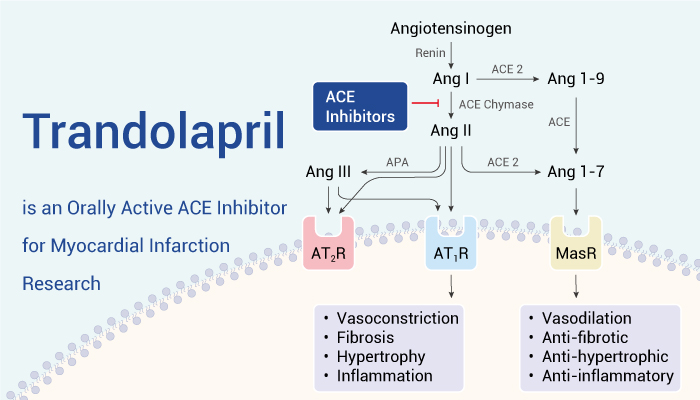Angiotensin converting enzyme (ACE) has the dual actions in converting inactive Ang I to active Ang II and degrade active Bradykinin, which play an important role in the control of blood pressure. Two isozymes of ACE are present in mammals: somatic ACE and testis ACE. Somatic ACE possesses two catalytic domains (N- and C-domains) and a C-terminal transmembrane segment (stalk). Testis ACE only possesses one catalytic domain. Both catalytic domains are zinc-metallopeptidase with the active motif HEMGH where the two histidine residues coordinate the zinc ion. The stalk anchors the enzyme on the membrane and is susceptible to be cleaved by shedding enzymes, resulting in plasma ACE activity.
The well-known function of ACE is the conversion of Ang I to Ang II and degradation of Bradykinin, which all play an important role in controlling blood pressure. ACE also acts on other natural substrates including Enkephalin, Neurotensin, and Substance P. Besides, ACE possesses widespread functions including renal development, male fertility, hematopoiesis, erythropoiesis, myelopoiesis, and immune responses. ACE-knockout mice display normal blood pressure under normal conditions, but are sensitive to changes in blood pressure such as exercise. ACE-knockout also affects renal function, renal development, serum and urine electrolyte composition, haematocrit, and male reproductive capacity. Deficiency in testis ACE affects male fertility but its exact role is still not clear. Although mice with testis ACE deficiency mate normally and their sperm quantity and motility are no different from those of wild-type mice, the survival of sperm in the oviduct and fertilization rate are highly reduced.
Trandolapril (RU44570) is an orally active non-sulhydryl prodrug that belongs to the ACE inhibitor
Trandolapril can be metabolized to its biologically active diacid form, Trandolaprilat, in the liver. Trandolapril is an orally active ACE inhibitor that is effective for hypertension and congestive heart failure, and after myocardial infarction. Trandolapril is similar in structure to another ramipril but has a cyclohexane group. It has a longer half-life when compared to other agents in this class. In obstructive nephropathy mice, Trandolapril reduces renal fibrosis by inhibiting renal interstitial matrix expression and myofibroblast activation, decreasing renal proinflammatory cytokine RANTES and TNF-α level. Besides, Trandolapril exhibits a chronic anti-hypertension effect in rats, results in blood pressure decreasing.
All in all, Trandolapril is an orally active ACE inhibitor and is effective in hypertension and congestive heart failure, and after myocardial infarction.
References:
[1] Fleming I, et, al. Circ Res. 2006 Apr 14;98(7):887-96.
[2] Reynolds NA, et, al. Drugs. 2005;65(13):1893-914.
